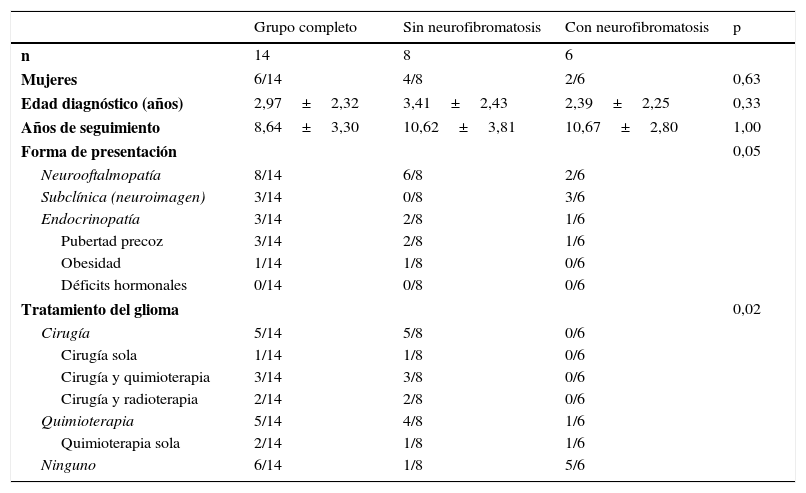Describir la frecuencia de endocrinopatías en niños con glioma del quiasma óptico y analizar los factores relacionados.
Pacientes y métodosRevisión de historias recogiendo las variables sexo, edad, antecedente de neurofibromatosis, forma de presentación, tratamiento del tumor y presencia de endocrinopatías. Pruebas estadísticas: Wilcoxon y Fisher.
ResultadosCatorce pacientes (6 mujeres) con edad al diagnóstico de 0,5 a 7,0años (media±desviación típica: 2,97±2,32) y tiempo de seguimiento de 10,64±3,30años (rango 6,0-16,0). Doce de 14 presentaban endocrinopatía al final del seguimiento: 8 pubertad precoz, 5 hipopituitarismo y 5 obesidad. La aparición de déficits se relacionó con la clínica neurooftalmológica antes de los 5años de edad (p=0,02) y con el requerimiento de tratamiento de la lesión (p=0,03).
ConclusionesLos niños con gliomas del quiasma óptico pueden presentar endocrinopatías desde el momento del diagnóstico del tumor y, sobre todo, a lo largo de su evolución. La más frecuente es la pubertad precoz. Los déficits hipofisarios se relacionan con los tumores más agresivos (aquellos que debutan con clínica neurooftalmológica antes de los 5años de edad y que requieren tratamiento).
To describe the frequency of endocrine disorders in children with optic chiasm glioma and analyze related factors.
Patients and methodsReview of medical records by collecting sex, age, history of neurofibromatosis, clinical presentation, treatment of tumour, and presence of endocrine abnormalities. Statistical tests Wilcoxon and Fisher.
Results14 patients (6 female) with age at diagnosis of 0.5 to 7.0 years (mean±standard deviation: 2.97±2.32) and follow-up of 10.64±3.30 years (range 6.0 to 16.0). 12/14 presented endocrinopathy at follow-up: 8 precocious puberty, 5 hypopituitarism, and 5 obesity. The onset of deficits was related to the neuroophthalmological symptoms under the age of five (P=.02)and treatment of the tumour was required.(P=.03).
ConclusionsChildren with optic chiasm gliomas may present endocrine disorders from the time of diagnosis of the tumor and, in particular as they develop on. The most common of these is precocious puberty. Pituitary deficits are associated with more aggressive tumours (those presenting with neuroophthalmological signs and symptoms before the age of five and requiring treatment).
Artículo
Comprando el artículo el PDF del mismo podrá ser descargado
Precio 19,34 €
Comprar ahora









